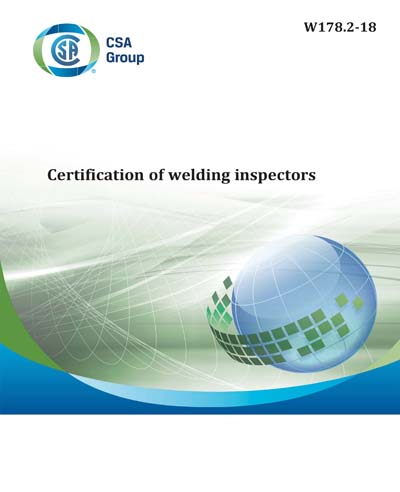Most recent
CSA W178.2-2018
Certification of welding inspectors
Preface
This is the seventh edition of CSA W178.2, Certification of welding inspectors. It supersedes the previous editions, published in 2014, 2008, 2001, 1996, 1990, and 1982. This Standard provides requirements for those seeking certification as welding inspectors. Individuals may be certified in accordance with this Standard regardless of whether they are employed by an inspection organization. The effectiveness of welding inspection depends largely on the knowledge and integrity of the individual responsible for carrying out the inspection. Thus, there is a need for inspectors with both appropriate knowledge and the capability of exercising responsible judgment. This Standard is not intended to replace an employer╞s final responsibility for the work or a supervisor╞s judgment of an individual╞s suitability to perform a given task.Scope
1.1 This Standard covers the certification of welding inspectors at three certification levels. It specifies the responsibilities and the basic technical functions associated with each level. 1.2 This Standard specifies the requirements for the periodic review of welding inspector certification, including vision tests. 1.3 This Standard, by including a code of ethics for the welding inspector, defines principles of practice and conduct for maintaining certification. 1.4 To assist candidates in preparing for examinations, this Standard contains knowledge requirements (see Annex A) covering a) welding fundamentals; b) welding inspection; and c) welding metallurgy. This Standard also includes a list of relevant reference publications (see Annex B). 1.5 This Standard does not address safety issues associated with welding. It is the responsibility of the users of this Standard to establish appropriate safety and health practices and determine the applicability of regulatory limitations. Note: CSA W117.2 addresses safety in welding, cutting, and allied processes. 1.6 This Standard does not address the certification of individuals performing non-destructive examinations using radiographic, ultrasonic, eddy current, magnetic particle, or liquid penetrant methods. CAN/CGSB-48.9712/ISO 9712 specifies the requirements for the certification of individuals performing these non-destructive examination methods. 1.7 This standard is not intended to specify the qualifications or supervision required to perform inspection work. Inspector competencies are provided only to aid in establishing training, experience, and testing objectives for each level. 1.8 In this Standard, "shall" is used to express a requirement, i.e., a provision that the user is obliged to satisfy in order to comply with the standard; "should" is used to express a recommendation or that which is advised but not required; and "may" is used to express an option or that which is permissible within the limits of the standard. Notes accompanying clauses do not include requirements or alternative requirements; the purpose of a note accompanying a clause is to separate from the text explanatory or informative material. Notes to tables and figures are considered part of the table or figure and may be written as requirements. Annexes are designated normative (mandatory) or informative (non-mandatory) to define their application.Content Provider
CSA America, Inc. [csa]






